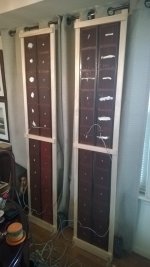Hi.
I'm in the beta testing phase 🙂 of my ESL speakers. I bought these panels from a friend. It was built by his dad many years ago and I got them probably about 7 years ago. It's been sitting in my house all this time and I finally decided to put it together. These are wire stators and they sound pretty good and strong down to about 150Hz. Since they've been sitting for such a long time and I do smoke cigars once in a while, I was thinking:
- is there a way I can clean the diaphragm without taking it apart? and of course without destroying the speaker.
- I can see some wrinkles on the diaphragm. Is there a way to stretch it? Maybe using a heat gun or a hair dryer?
Thanks for the help.
Elias

I'm in the beta testing phase 🙂 of my ESL speakers. I bought these panels from a friend. It was built by his dad many years ago and I got them probably about 7 years ago. It's been sitting in my house all this time and I finally decided to put it together. These are wire stators and they sound pretty good and strong down to about 150Hz. Since they've been sitting for such a long time and I do smoke cigars once in a while, I was thinking:
- is there a way I can clean the diaphragm without taking it apart? and of course without destroying the speaker.
- I can see some wrinkles on the diaphragm. Is there a way to stretch it? Maybe using a heat gun or a hair dryer?
Thanks for the help.
Elias

I've used a hair dryer on diaphragms over the years. It is a rather narrow band between ineffective temperature and over-heated damage. Can't say as I have measured or otherwise evaluated whether my treatment had any effect ever.
But if you can see creases, you are able to assess if you are having some good results as you proceed.
When you wire up the bias, remember to use 20-60 megOhms in series and to give cells maybe 15 minutes to charge.
Ben
But if you can see creases, you are able to assess if you are having some good results as you proceed.
When you wire up the bias, remember to use 20-60 megOhms in series and to give cells maybe 15 minutes to charge.
Ben
I've used a hair dryer on diaphragms over the years. It is a rather narrow band between ineffective temperature and over-heated damage. Can't say as I have measured or otherwise evaluated whether my treatment had any effect ever.
But if you can see creases, you are able to assess if you are having some good results as you proceed.
When you wire up the bias, remember to use 20-60 megOhms in series and to give cells maybe 15 minutes to charge.
Ben
Hi Ben.
I did try the hair dryer but not very effective. Of course the next step was to try the heat gun, which I did and it worked really well, but being a diy project, I messed up 😡 and caused a few spots of heat damage to the mylar
 . Thankfully it was right next to the frame and very small. It did not affect the sound at all and according to some posts from Tyu, it seems that it should be OK in the long term. The diaphragm is now very straight with no wrinkles. I was hearing a buzzing distortion specially during strong piano passages, but now it's all good and the sound is clear and clean
. Thankfully it was right next to the frame and very small. It did not affect the sound at all and according to some posts from Tyu, it seems that it should be OK in the long term. The diaphragm is now very straight with no wrinkles. I was hearing a buzzing distortion specially during strong piano passages, but now it's all good and the sound is clear and clean  . Lesson learned: heat gun works well, but you need to be very careful.
. Lesson learned: heat gun works well, but you need to be very careful.Thanks.
Elias
Kidding aside, briefly, there must be an ergonomically sound way to use a dryer to get uniform results? I use an infra-red thermometer on trick stuff like loosening the Loktite-glue just to the right temperature without cooking the paint on motorcycle bolts (a useful tool to own).
Ben
Ben
- Status
- Not open for further replies.